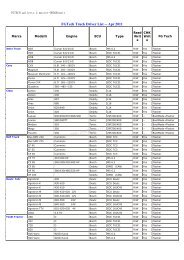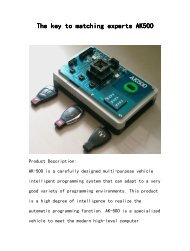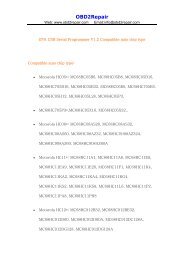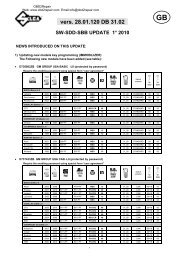BEEPROG Universal programmer Manual.pdf - OBD2Repair
BEEPROG Universal programmer Manual.pdf - OBD2Repair
BEEPROG Universal programmer Manual.pdf - OBD2Repair
- No tags were found...
You also want an ePaper? Increase the reach of your titles
YUMPU automatically turns print PDFs into web optimized ePapers that Google loves.
<strong>OBD2Repair</strong>Web: www.obd2repair.com Email:info@obd2repair.com<strong>BEEPROG</strong> <strong>Universal</strong> <strong>programmer</strong> <strong>Manual</strong>Short description:• ‐‐33901 supported devices by 2.42 version of SW (13. Sep. 2007)• ‐‐extremely fast programming, one of the fastest <strong>programmer</strong>s in thiscategory. Programs 16‐Mbit Flash memory less than 18 seconds• ‐‐48‐pins powerful pindrivers, no adapter required for any DIL devices• ‐‐connector for in‐circuit programming (ISP)• ‐‐dual connection to PC: USB or parallel (printer) port• ‐‐USB 2.0/1.1 compatible interface• ‐‐alternatively high‐speed IEEE 1284 (ECP/EPP) printer‐port (LPT) interface• ‐‐comfortable and easy to use control program, Windows95/98/Me/NT/2000/XP/2003/XPx64 compatible• ‐‐Multiprogramming possible by attaching more <strong>programmer</strong>s to one PC• ‐‐warranty ‐ 3 yearsOptional accessories:• ‐‐socket converters• ‐‐Diagnostic POD for ISP connectorFeatures:GENERAL• ‐‐First member of new USB‐compatible generation of Windows95/98/ME/NT/2000/XP/2003/XP64 based ELNEC universal <strong>programmer</strong>s builtto meet the strong demand of the developers community for the fast andreliable universal <strong>programmer</strong>.• ‐‐Supports all kinds of types and silicon technologies of today and tomorrowprogrammable devices without family‐specific module. You have freedom tochoose the optimal device for your design. Using built‐in in‐circuit serialprogramming (ISP) connector, the <strong>programmer</strong> is able to program ISP capablechips in circuit.• ‐‐BeeProg isn't only a <strong>programmer</strong>, but also a tester of TTL/CMOS logic ICsand memories. Furthermore, it allows generation of user‐definable testpattern sequences.• ‐‐Provides very competitive price coupled with excellent hardware design forreliable programming. Probably best "value for money"<strong>programmer</strong> in thisclass.
<strong>OBD2Repair</strong>Web: www.obd2repair.com Email:info@obd2repair.com• Very fast programming due to high‐speed FPGA driven hardware andexecution of time‐critical routines inside of the <strong>programmer</strong>. At least fastthan competitors in this category, for many chips much faster than mostcompetitors. As a result, when used in production thisone‐socket‐<strong>programmer</strong> waits for an operator, and not the other way round.• ‐‐BeeProg interfaces with the IBM PC 486 compatible or higher, portable ordesktop personal computers through USB (2.0/1.1) port or any standardparallel (printer) port. Programmer also supports IEEE1284 (ECP/EPP)high‐speed parallel port. Support of both USB/LPT port connection gives youthe choice to connect the BeeProg <strong>programmer</strong> to any PC, from latestnotebook to older desktop without USB port.HARDWARE:• ‐‐FPGA based totally reconfigurable 48 powerful TTL pindrivers provideH/L/pull_up/pull_down and read capability for each pin of socket. Advancedpindrivers incorporate high‐quality high‐speed circuitry to deliver signalswithout overshoot or ground bounce for all supported devices. Pin driversoperate down to 1.8V so you'll be ready to program the full range of today'sadvanced low‐voltage devices.• ‐‐The <strong>programmer</strong> performs device insertion test (wrong or backwardposition) and contact check (poor contact pin‐to‐socket) before it programseach device. These capabilities, supported by overcurrent protection andsignature‐byte check help prevent chip damage due to operator error.• ‐‐The selftest capability allow to run diagnostic part of software to thoroughlycheck the health of the <strong>programmer</strong>.• ‐‐Built‐in protection circuits eliminate damage of <strong>programmer</strong> and/orprogrammed device due to environment or operator failure. All the inputs ofthe BeeProg <strong>programmer</strong>, including the ZIF socket, connection to PC andpower supply input, are protected against ESD up to 15kV.• ‐‐BeeProg <strong>programmer</strong> performs programming verification at the marginallevel of supply voltage, which, obviously, improves programming yield, andguarantees long data retention.• ‐‐Various socket converters are available to handle device in PLCC, SOIC,PSOP, SSOP, TSOP, TSSOP, TQFP, QFN (MLF), SDIP, BGA and other packages.+‐SOFTWARE
<strong>OBD2Repair</strong>Web: www.obd2repair.com Email:info@obd2repair.com• ‐‐Programmer is driven by an easy‐to‐use control program with pull‐downmenu, hot keys and on‐line help. Selecting of device is performed by its class,by manufacturer or simply by typing a fragment of vendor name and/or partnumber.• ‐‐Standard device‐related commands (read, blank check, program, verify,erase) are boosted by some test functions (insertion test, signature‐bytecheck), and some special functions (autoincrement, production mode ‐ startimmediately after insertion of chip into socket).• ‐‐All known data formats are supported. Automatic file format detection andconversion during loading of file.• ‐‐The rich‐featured auto‐increment function enables one to assign individualserial numbers to each programmed device ‐ or simply increments a serialnumber, or the function enables one to read serial numbers or anyprogrammed device identification signatures from a file.• ‐‐The software also provide a many information about programmed device.As a special, the drawing of all available packages are provided. The softwareprovide also explanation of chip labelling (the meaning of prefixes andsuffixes at the chips) for each supported chip.• ‐‐The software provide a full information for ISP implementation: Descriptionof ISP connector pins for currently selected chip, recommended target designaround in‐circuit programmed chip and other necessary information.• ‐‐The remote control feature allows to be PG4UW software flow controlledby other application ?§C either using .BAT file commands or using DLL file.• DLL file, examples (C/PAS) and manual are part of standard software delivery.• ‐‐Jam files of JEDEC standard JESD‐71 are interpreted by Jam Player. Jam filesare generated by design software which is provided by manufacturer ofrespective programmable device. Chips are <strong>programmer</strong> in‐ZIF or through ISPconnector (IEEE 1149.1 Joint Test Action Group (JTAG) interface).• ‐‐VME files are interpreted by VME Player. VME file is a compressed binaryvariation of SVF file and contains high‐level IEEE 1149.1 bus operations. VMEfiles are generated by design software which is provided by manufacturer ofrespective programmable device. Chips are <strong>programmer</strong> in‐ZIF or through ISPconnector (IEEE 1149.1 Joint Test Action Group (JTAG) interface).• ‐‐Multiple devices are possible to program and test via JTAG chain: JTAGchain (ISP‐Jam) or JTAG chain (ISP‐VME).
<strong>OBD2Repair</strong>Web: www.obd2repair.com Email:info@obd2repair.com• ‐‐Attaching of more BeeProg <strong>programmer</strong>s to the same PC (through USB port)is achieved a powerful multiprogramming system, which support as manychips, as are supported by BeeProg <strong>programmer</strong> and without obviousdecreasing of programming speed. It is important to know, there is aconcurrent multiprogramming ‐ each <strong>programmer</strong> works independently andeach <strong>programmer</strong> can program different chip, if necessary.Specification• Base unit, DACs• ‐‐USB 2.0 port• ‐‐FPGA based IEEE 1284 slave printer port, up to 1MB/s transfer rate• ‐‐on‐board intelligence: powerful microprocessor and FPGA based statemachine• ‐‐three D/A converters for VCCP, VPP1, and VPP2, controllable rise and falltime• ‐‐VCCP range 0..8V/1A• ‐‐VPP1, VPP2 range 0..26V/1A• ‐‐autocalibration• ‐‐selftest capability• ‐‐protection against surge and ESD on power supply input, parallel portconnectionZIF socket, pindriver• ‐‐48‐pin DIL ZIF (Zero Insertion Force) socket accepts both 300/600 mildevices up to 48‐pin• ‐‐pindrivers: 48 universal• ‐‐VCCP/VPP1/VPP2 can be connected to each pin• ‐‐perfect ground for each pin• ‐‐FPGA based TTL driver provides H, L, CLK, pull‐up, pull‐down on all pindriverpins• ‐‐analog pindriver output level selectable from 1.8 V up to 26V• ‐‐current limitation, overcurrent shutdown, power failure shutdown• ‐‐ESD protection on each pin of socket (IEC1000‐4‐2: 15kV air, 8kV contact)• ‐‐continuity test: each pin is tested before every programming operationISP connector• ‐‐10‐pin male type with missinsertion lock• ‐‐5 TTL pindrivers, provides H, L, CLK, pull‐up, pull‐down; level H selectablefrom 1.8V up to 5V to handle all (low‐voltage including) devices.• ‐‐1x VCCP voltage (range 2V..7V/100mA), can be applied to pins 1, 3
<strong>OBD2Repair</strong>Web: www.obd2repair.com Email:info@obd2repair.com• programmed chip voltage (VCCP) with both source/sink capability andvoltage sense• ‐‐1x VPP voltage (range 2V..25V/50mA), can be applied to pins 2,3,4,6,8,10• ‐‐target system supply voltage (range 2V..6V/250mA)DEVICE SUPPORTProgrammer, in ZIF socket• ‐‐EPROM: NMOS/CMOS, 2708*, 27xxx and 27Cxxx series, with 8/16 bit datawidth, full support for LV series• ‐‐EEPROM: NMOS/CMOS, 28xxx, 28Cxxx, 27EExxx series, with 8/16 bit datawidth• ‐‐Flash EPROM: 28Fxxx, 29Cxxx, 29Fxxx, 29BVxxx, 29LVxxx, 29Wxxx, 49Fxxx‐‐series, from 256Kbit to 32Mbit, with 8/16 bit data width, full support for LVseries• Serial E(E)PROM: 24Cxxx, 24Fxxx, 25Cxxx, 45Dxxx, 59Cxxx, 25Fxxx, 25Pxxx,85xxx, 93Cxxx, NVM3060, MDAxxx series, full support for LV series• ‐‐Configuration (EE)PROM: XCFxxx, XC17xxxx, XC18Vxxx, EPCxxx, AT17xxx,37LVxx• ‐‐1‐Wire E(E)PROM: DS1xxx, DS2xxx• ‐‐PROM: AMD, Harris, National, Philips/Signetics, Tesla, TI• ‐‐NV RAM: Dallas DSxxx, SGS/Inmos MKxxx, SIMTEK STKxxx, XICOR 2xxx, ZMDU63x series• ‐‐PLD: Altera: MAX 3000A, MAX 7000A, MAX 7000B, MAX 7000S, MAX7000AE• ‐‐PLD: Lattice: ispGAL22V10x, ispLSI1xxx, ispLSI1xxxEA, ispLSI2xxx, ispLSI2xxxA,ispLSI2xxxE, ispLSI2xxxV, ispLSI2xxxVE, ispLSI2xxxVL, LC4xxxB/C/V/ZC,M4‐xx/xx, M4A3‐xx/xx, M4A5‐xx/xx, M4LV‐xx/xx• ‐‐PLD: Xilinx: XC9500, XC9500XL, XC9500XV, CoolRunner XPLA3,CoolRunner‐II• ‐‐other PLD: SPLD/CPLD series: AMI, Atmel, AMD‐Vantis, Gould, Cypress, ICT,Lattice, NS, Philips, STM, VLSI, TI• ‐‐Microcontrollers 48 series: 87x41, 87x42, 87x48, 87x49, 87x50 series• ‐‐Microcontrollers 51 series: 87xx, 87Cxxx, 87LVxx, 89Cxxx, 89Sxxx, 89LVxxx,all Manufacturers, Philips LPC series• ‐‐Microcontrollers Intel 196 series: 87C196 KB/KC/KD/KT/KR/...• ‐‐Microcontrollers Atmel AVR: AT90Sxxxx, ATtiny, ATmega series• ‐‐Microcontrollers Cypress: CY8Cxxxxx• ‐‐Microcontrollers ELAN: EM78Pxxx• ‐‐Microcontrollers MDT 1xxx and 2xxx series
<strong>OBD2Repair</strong>Web: www.obd2repair.com Email:info@obd2repair.com• ‐‐Microcontrollers Microchip PICmicro: PIC10xxx, PIC12xxx, PIC16xxx,PIC17Cxxx, PIC18xxx, DSPIC series• ‐‐Microcontrollers Motorola (Freescale): 68HC05, 68HC08, 68HC11 series• ‐‐Microcontrollers Myson MTV2xx, 3xx, 4xx and 5xx series• ‐‐Microcontrollers National: COP8xxx series• ‐‐Microcontrollers NEC: uPD78Fxxx series• ‐‐Microcontrollers Scenix (Ubicom): SXxxx series• ‐‐Microcontrollers SGS‐Thomson: ST6xx, ST7xx, ST10xx series• ‐‐Microcontrollers TI: MSP430 and MSC121x series• ‐‐Microcontrollers ZILOG: Z86/Z89xxx and Z8xxx series• ‐‐Microcontrollers other: EM Microelectronic, Fujitsu, Goal Semiconductor,Hitachi, Holtek, Princeton, Macronix, Winbond, Infineon(Siemens), Samsung,Toshiba, ...Programmer, through ISP connector• ‐‐Serial E(E)PROM: IIC series, MW series, SPI series, KEELOQ series, serial dataFlash, PLD configuration memories• ‐‐Microcontrollers Atmel: AT89Sxxx, AT90Sxxxx, ATtiny, ATmega series• ‐‐Microcontrollers Cypress: CY8C2xxxx• ‐‐Microcontrollers Elan: EM78Pxxx, EM6xxx series• ‐‐Microcontrollers EM Microelectronic: 4 and 8 bit series• ‐‐Microcontrollers Microchip PICmicro: PIC10xxx, PIC12xxx, PIC16xxx,PIC17xxx, PIC18xxx, dsPIC series• ‐‐Microcontrollers Motorola/Freescale: HC11 series, HC908 series (both5‐wire, All‐wire)• ‐‐Microcontrollers NEC: uPD7xxx series• ‐‐Microcontrollers Philips: LPC2xxx series, LPC series, 89xxx series• ‐‐Microcontrollers Scenix (Ubicom): SXxxx series• ‐‐Microcontrollers TI: MSP430 (both JTAG and BSL series), MSC12xxx series• ‐‐PLD: Lattice: ispGAL22xV10x, ispLSI1xxxEA, ispLSI2xxxE, ispLSI2xxxV,ispLSI2xxxVE, ispLSI2xxxVL, M4‐xx/xx, M4LV‐xx/xx, M4A3‐xx/xx, M4A5‐xx/xx,LC4xxxB/C/V/ZC• ‐‐Various PLD (also by JAM player/JTAG support):• Altera: MAX 3000A, MAX 7000A, MAX 7000B, MAX 7000S, MAX 9000, MAX II• Xilinx: XC9500, XC9500XL, XC9500XV, CoolRunner XPLA3, CoolRunner‐IINotes:• ‐‐devices marked * are obsolete, programming with additional module• ‐‐for all supported devices see actual DEVICE LIST
<strong>OBD2Repair</strong>Web: www.obd2repair.com Email:info@obd2repair.com• I.C. Tester‐‐TTL type: 54,74 S/LS/ALS/H/HC/HCT series‐‐CMOS type: 4000, 4500 series‐‐Static RAM: 6116 .. 624000‐‐User definable test pattern generationPackage support• ‐‐support all devices in DIP with default socket• ‐‐package support includes DIP, SDIP, PLCC, JLCC, SOIC, SOP, PSOP, SSOP,TSOP, TSOPII, TSSOP, QFP, PQFP, TQFP, VQFP, QFN (MLF), SON, BGA, EBGA,FBGA, VFBGA, UBGA, CSP, SCSP etc.• ‐‐support devices in non‐DIP packages up to 48 pins with universal adapters• ‐‐<strong>programmer</strong> is compatible with third‐party adapters for non‐DIP supportProgramming speedNotes:• ‐‐It is important to know, we always use random numbers pattern forprogramming speed testing. Some our competitors use "sparse" pattern,where only few non‐Blak data are programmed or are there are used datawith only few 0 bits (FE, EF, etc.). This cheating approach can "decrease"programming time considerable. If you plan to compare, ask always whichpattern they use.• ‐‐The programming speed depends on PC speed only slightly.• ‐‐If the <strong>programmer</strong> attached to PC through LPT port, the programming mighttake longer.Device/ Size [bits] Operation /Time• 1.M50FW080 (parallel Flash) 100000Hx8 (8 Mega) programming and verify22 sec.• 2.AM29DL323DB (parallel Flash) 208000Hx16 (32 Mega) programming andverify 31 sec.• 3.AM29DL640 (parallel Flash) 400080Hx16 (64 Mega) programming andverify 61 sec.• 4.AT45D081 (serial Flash) 108000Hx8 (16 Mega) programming and verify 41sec.• 5.AT89C51RD2 (microcontroller) 10000Hx8 programming and verify 15 sec.• 6.PIC18LF452 (microcontroller) 4000Hx16 programming and verify 4 sec.• Conditions: PC Pentium 4, 2.4 GHz, USB 2.0, Windows XP.
<strong>OBD2Repair</strong>Web: www.obd2repair.com Email:info@obd2repair.comSOFTWARE• ‐‐Algorithms: only manufacturer approved or certified algorithms are used.Custom algorithms are available at additional cost.• ‐‐Algorithm updates: software updates are available regulary, approx. every 2weeks, free of charge.• ‐‐Main features: revision history, session logging, on‐line help, device andalgorithm information.Device operations1.standard:• ‐‐intelligent device selection by device type, manufacturer or typed fragmentof part name• ‐‐automatic ID‐based selection of EPROM/Flash EPROM• ‐‐blank check, read, verify• ‐‐program• ‐‐erase• ‐‐configuration and security bit program• ‐‐illegal bit test• ‐‐checksum• ‐‐interprete the Jam Standard Test and Programming Language (STAPL),JEDEC standard JESD‐71• ‐‐interprete the VME files compressed binary variation of SVF files2.security• ‐‐insertion test, reverse insertion check• ‐‐contact check• ‐‐ID byte check3.special• ‐‐production mode (automatic start immediately after device insertion)• ‐‐auto device serial number increment• ‐‐statistic• ‐‐count‐down modeBuffer operations• ‐‐view/edit, find/replace• ‐‐fill/copy, move, byte swap, word/dword split
<strong>OBD2Repair</strong>Web: www.obd2repair.com Email:info@obd2repair.com• ‐‐checksum (byte, word)• ‐‐printFile load/save• ‐‐no download time because <strong>programmer</strong> is PC controlled• ‐‐automatic file type identification/recognitionSupported file formats:• ‐‐unformatted (raw) binary• ‐‐HEX: Intel, Intel EXT, Motorola S‐record, MOS, Exormax, Tektronix,ASCII‐SPACE‐HEX,, ASCII HEX• ‐‐Altera POF, JEDEC (ver. 3.0.A), eg. from ABEL, CUPL, PALASM, TANGO PLD,OrCAD PLD, PLD Designer ISDATA, etc.• ‐‐JAM (JEDEC STAPL Format), JBC (Jam STAPL Byte Code), STAPL (STAPL File)JEDEC standard JESD‐71• ‐‐VME (ispVME file VME2.0/VME3.0)GENERAL:• PC system requirements• ‐‐Common, software related requirements• ‐‐Programmer hardware related requirements:• ‐‐either one USB port, 2.0 compatible• ‐‐or one (parallel) printer port with nothing attached, the IEEE 1284compatible printer port (ECP/EPP) on PCI bus recommendedOperation• ‐‐operating voltage 15V..18V DC, max. 1A• ‐‐power consumption max. 12W active, about 2W sleep• ‐‐dimensions 160x190x42 mm (6.3x7.5x1.7 inch)• ‐‐weight (without external adapter) 0.9kg (1.98 lb)• ‐‐temperature 5¡ãC ¡Â 40¡ãC (41¡ãF ¡Â 104¡ãF)• ‐‐humidity 20%..80%, non condensingPackage includes:• ‐‐BeeProg <strong>programmer</strong>• ‐‐switching power adapter 100..240V AC/15V DC/1A• ‐‐connection cable PC‐<strong>programmer</strong>, LPT port• ‐‐connection cable PC‐<strong>programmer</strong>, USB port• ‐‐ISP cable
<strong>OBD2Repair</strong>Web: www.obd2repair.com Email:info@obd2repair.com• ‐‐diagnostic POD for selftest of the <strong>programmer</strong>• ‐‐anti‐dust cover for ZIF socket• ‐‐user manual• ‐‐software• ‐‐registration card• ‐‐calibration test report• ‐‐transport caseAdditional services:• ‐‐Keep Current ‐ ELNEC sends to user the latest version of <strong>programmer</strong>software and updated user documentation (Keep‐Current package)• ‐‐AlgOR (Algorithms On Request) ‐ add new supported devices on customerrequest


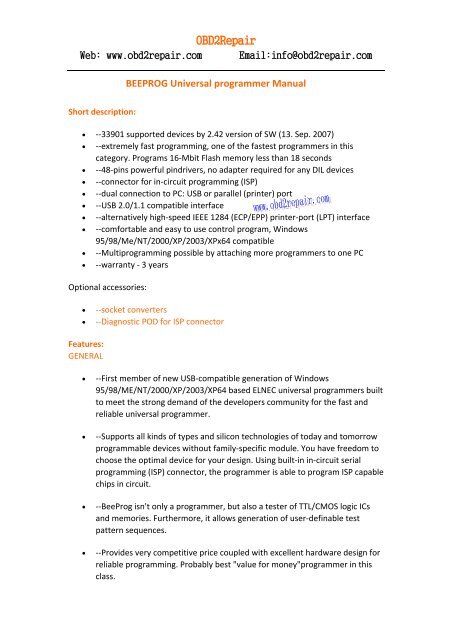

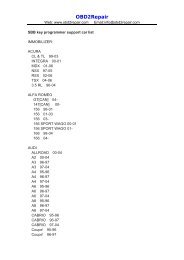

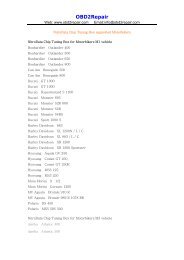
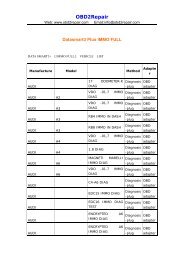
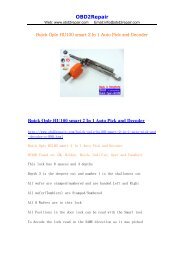
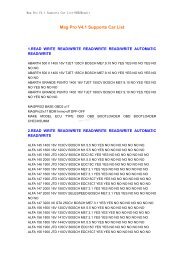
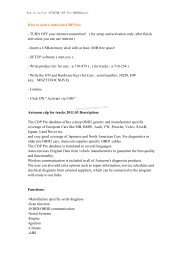
![NitroData [Chip Tuning Box] for Diesel Car (commonrail)](https://img.yumpu.com/34375830/1/190x135/nitrodata-chip-tuning-box-for-diesel-car-commonrail.jpg?quality=85)
